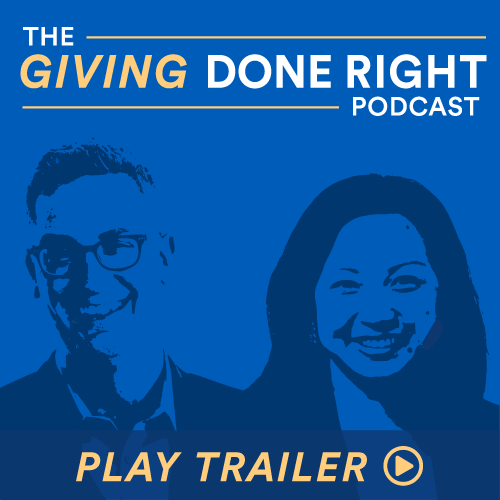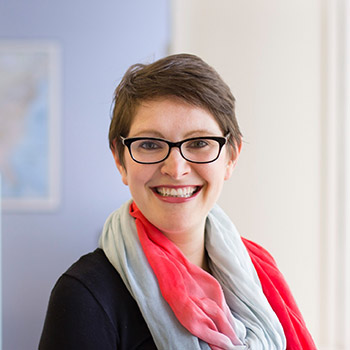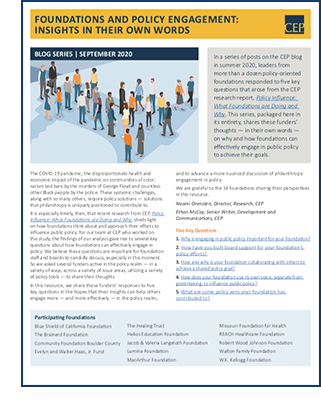Have you subscribed yet to the Giving Done Right podcast?

Whether you’re donating a few hundred dollars a year, a few thousand, or a few million, you might find yourself wondering: Where should I give? How do I know which nonprofits are effective? How do I know if I’m really making a difference with my donation? Giving Done Right, a new podcast from CEP premiering this Thursday, is here to help answer these crucial questions — and more.
In a time when effective giving is especially crucial, Giving Done Right will cut through the noise and focus on what you need to know to put your money to work. In each episode, hosts Phil Buchanan and Grace Nicolette will be joined by an expert guest to explore philanthropy’s burning questions. “Together, we’ll bust some myths that have long plagued donors and nonprofits alike; we’ll draw connections to how giving can counter racial inequality; and we’ll explore the roles of faith, family, and identity in giving,” writes Nicolette in a blog post introducing the show.
You can listen to the trailer here, and be sure to subscribe on Apple Podcasts, Spotify, Stitcher, or wherever you get your podcasts.
Tune in every Thursday this fall!
Reach out by Wednesday for a discount on your 2021 CEP assessment!
The deadline to take advantage of an early-bird discount offer on any CEP assessment or customized advisory services engagement in 2021 is this Wednesday! This is the only discount window for next year’s assessments, so don’t delay!
Philanthropy needs to listen to its stakeholders now — carefully, regularly, and comprehensively — to rise to the challenge and be truly effective in its work in 2021. CEP’s assessments can help. We’ve added new survey questions and approaches to ensure that funders hear candidly from important partners about the topics that matter most right now. In particular, our surveys include several questions specifically focused on racial equity — including questions that help funders understand how much of their grantmaking is ultimately intended to benefit historically disadvantaged groups (particularly BIPOC communities and individuals), and questions that ask grantees to assess aspects of their funder’s commitment to diversity, equity, and inclusion.
Read more about how CEP is evolving its assessments to help funders ask the right questions for meeting the moment in this blog post from Mena Boyadzhiev and Sonia Montoya, and don’t forget to contact CEP Director, Assessment and Advisory Services, Austin Long by Wednesday to receive a discount on your 2021 assessment.
New Attitudes, Old Practices: The Provision of Multiyear, General Operating Support

Nonprofit leaders have long called for long-term, flexible grants to help their organizations flexibly apply funds to fulfill their missions and plan for the future. For years now, philanthropic and nonprofit leaders have argued that multiyear general operating support (GOS) constitutes good grantmaking practice.
But nonprofits rarely receive these grants. What gives?
Drawing on findings from soon-to-be-released CEP research exploring why so few foundations provide these grants, this interactive webinar discussion on October 27 will delve into the approaches of two foundations that intentionally provide more multiyear GOS grants than typical: The California Wellness Foundation and Foundation for a Just Society. The conversation will also explore the role of flexible grants in the current moment, as philanthropy is called to respond to and reckon with compounding public health, economic, and racial justice crises.
CEP Vice President, Research, Ellie Buteau will present findings from the new research, followed by a conversation with California Wellness Foundation Vice President of Programs Fatima Angeles and Foundation for a Just Society Director of Programs Maitri Moraji, moderated by Hilary Pennington of the Ford Foundation.
Understanding the Impact of COVID-19 on Nonprofits


What are the immediate and long-term impacts of the COVID-19 pandemic and resulting economic crisis on nonprofits? How are organizations coping and what new challenges should they anticipate? What are some of the opportunities and lessons learned for nonprofit leaders navigating this crisis?
This Wednesday at 2:00 pm ET, join Understanding the Impact of COVID-19 on Nonprofits, a free webinar hosted by Candid that will draw from data-driven insights from CEP and Charities Aid Foundation (CAF) to explore answers to these crucial questions. CEP Director, Research, Naomi Orensten will share findings from a June CEP study that draws from a nationally representative survey of nonprofit leaders to shed light on which nonprofit organizations face the toughest challenges right now — and what is most needed from funders. Joining Orensten in conversation will be Candid’s Executive Vice President Jacob Harold and Research Associate Sarina Dayal.
Students Weigh In on COVID-19: It’s Time to Listen

The COVID-19 pandemic has dramatically reshaped education in the U.S. — schools across the country were forced to close in spring 2020 and more than 50 million students were asked to learn remotely. To better understand how students experienced this spring’s school closures, YouthTruth — a national nonprofit housed within CEP — analyzed survey data from more than 20,000 students in grades 5-12. Here’s what they found:
- Only half of students said their teachers give them assignments that really help them learn and 39 percent said they learn a lot every day.
- Distractions at home and feeling depressed, stressed, or anxious were the most frequently cited obstacles to virtual learning. Black and Latinx students faced more obstacles than white and Asian students.
- Relationships with teachers were a bright spot, while sense of belonging suffered.
- Females and students who identify in another way rated their health and well-being less positively than males.
- One in five high school seniors’ postsecondary plans changed.
Read the full findings and dig into the data in Students Weigh In: Learning & Well-Being During COVID-19.
YouthTruth also hosted a national virtual discussion on the findings last month in which YouthTruth’s Jen de Forest and Jimmy Simpson, Jr. presented key insights, followed by a discussion among three visionary leaders from school systems that participated in the project about their hands-on experience incorporating student voice in planning for fall 2020. You can watch a recording of the conversation here, and download the presentation of the data here.
For even more discussion of the data, check out coverage of the study in The 74, Education Dive, The Hechinger Report, and Ed Week, as well as a post from YouthTruth Executive Director Jen Wilka on the CEP blog. “As philanthropy seeks to shift power dynamics and listen more deeply to the people and communities they seek to help, student voices and experiences must be at the heart of efforts to reimagine school,” Wilka writes. “As we move forward, we must hear their voices and take them to heart.”
What Foundation Leaders Have to Say About Policy Influence — in Their Own Words

In a series of posts on the CEP blog this summer, leaders from more than a dozen policy-oriented foundations responded to five key questions that arose from the CEP research report, Policy Influence: What Foundations are Doing and Why:
- Why is engaging in public policy important for your foundation?
- How have you built board support for your foundation’s policy efforts?
- How and why is your foundation collaborating with others — grantees, other funders — to achieve a shared policy goal?
- How — and when and why — does your foundation use its own voice, separate from grantmaking, to influence public policy?
- What are some policy wins your foundation has contributed to?
This series, packaged here in its entirety, shares these funders’ thoughts — in their own words — on why and how foundations can effectively engage in public policy to achieve their goals.
On the Blog
Leaha Wynn, manager, people and culture, and diversity and inclusion strategist at CEP, asks what philanthropy might need to sacrifice to address racism. “In short, power,” she contends.
Crystal Hayling, executive director of the Libra Foundation and former CEP board member, discusses the approach of a new funder collaborative supporting Black-led organizations: “We’re listening to the will and self-determined priorities of Black communities, supporting them, and getting out of the way.”
CEP President Phil Buchanan turns a critical eye to several upbeat assessments of philanthropy’s response to the current crisis — and argues that entities that offer donor-advised funds (DAFs) are in a position to step up to meet the unprecedented needs of the moment.
Naomi Orensten, director, research, at CEP, lays out four examples of how philanthropic advocacy efforts can support an effective response to the country’s compounded crises. “At its best,” Orensten writes, “philanthropic engagement in policy elevates unheard voices, advances justice and equity, fuels democracy, and holds government to account.”
Fund for Shared Insight Managing Director Melinda Tuan reflects on three key findings from CEP’s recent study, Funder Support During the COVID-19 Pandemic, and offers four steps funders can take to listen to and meaningfully respond to the needs of organizations that serve communities of color.
Gabriel Kasper and Justin Marcoux of Monitor Institute by Deloitte make the case for why, in a time with so much uncertainty, effective scenario-planning is a necessity if philanthropy is to rise to the occasion and support resilient organizations through the twists and turns ahead of us.
Lowell Weiss and Mario Morino draw from “The Big Reset,” a new resource from the Leap Ambassadors Community, to share nine pieces of practical advice for funders on how to step up to help grantees survive our current crises.
CEP’s Amsterdam-based Manager, Assessment and Advisory Services, Charlotte Brugman shared the final three profiles in a series on high-performing European funders, as identified through analysis of CEP’s comparative Grantee Perception Report (GPR) dataset:
- Tamara Pels-Idrobo Tapia and Shikha Sethia of Mama Cash discuss how the international women’s fund has developed processes that grantees find genuinely helpful.
- America for Bulgaria Foundation’s Desislava Taliokova, Ivanka Tzankova, and Ivo Bossev shed light on the value the Foundation’s grantees find in its provision of various forms of intensive non-monetary assistance.
- Tim Wilson shares insights into how City Bridge Trust, an independent grantmaker in central London, approaches its work in a way that intentionally practices transparency.
Emily Young, executive director of the Nonprofit Institute at the University of San Diego, shares three lessons about effective relationship-building drawn from Legler Benbough Foundation on the eve of its spend down.
Sandra Swirski, executive director of the Alliance for Charitable Reform, and Joanne Florino, vice president of philanthropic services at the Philanthropy Roundtable, discuss how taking the long view and exercising patience can be an effective strategy for foundations engaging in public policy.
And Lisa Gable, CEO of FARE (Food Allergy Research & Education), discusses the organization’s policy advocacy work — showing an example of how one nonprofit organization, with the support of philanthropy, is engaging in advocacy to achieve its mission.
Support CEP
If you believe in CEP’s work, and if it benefits you and your organization as you seek to do yours, please consider making a grant or an individual contribution to CEP. Supporting CEP means supporting more effective philanthropy.
